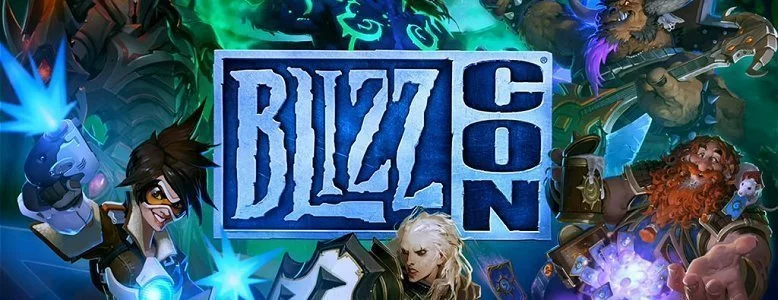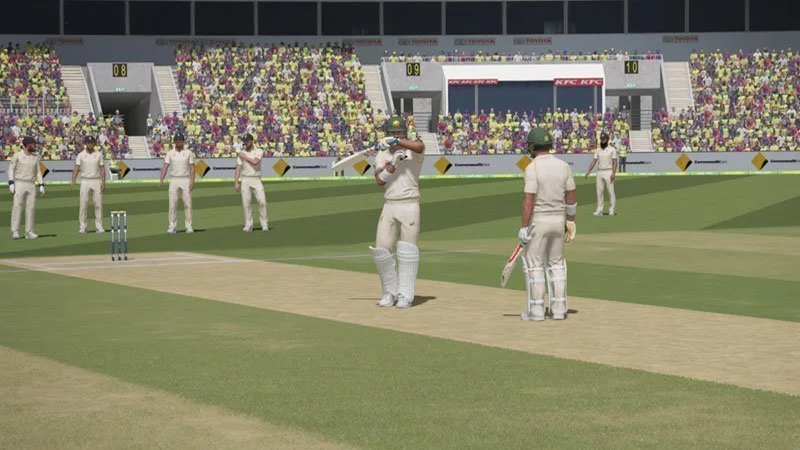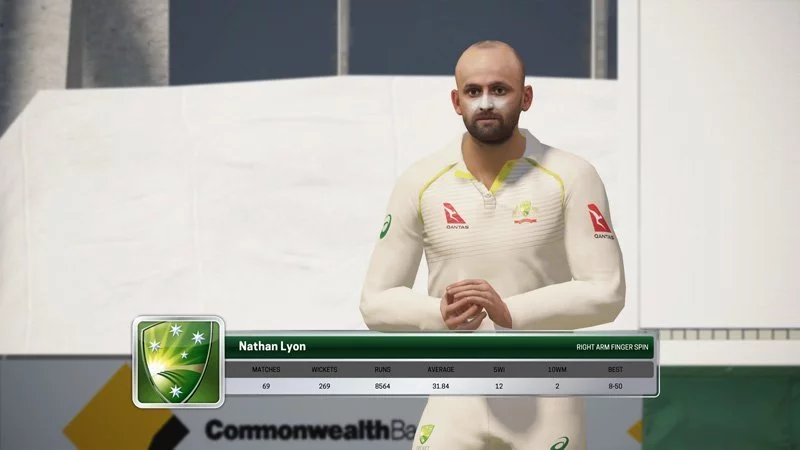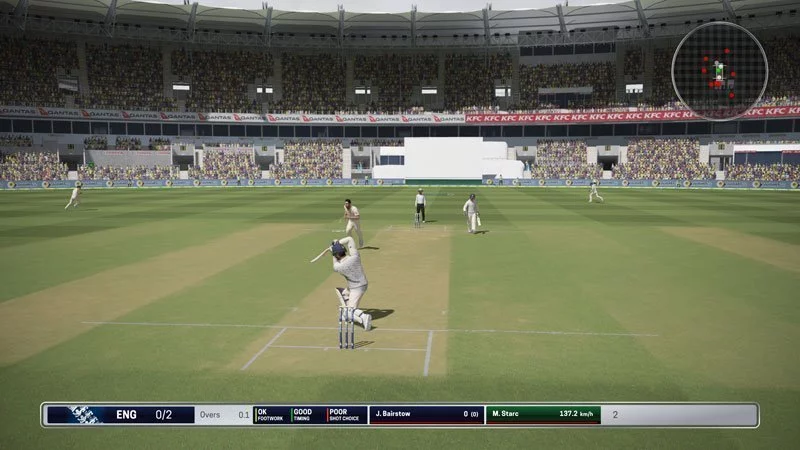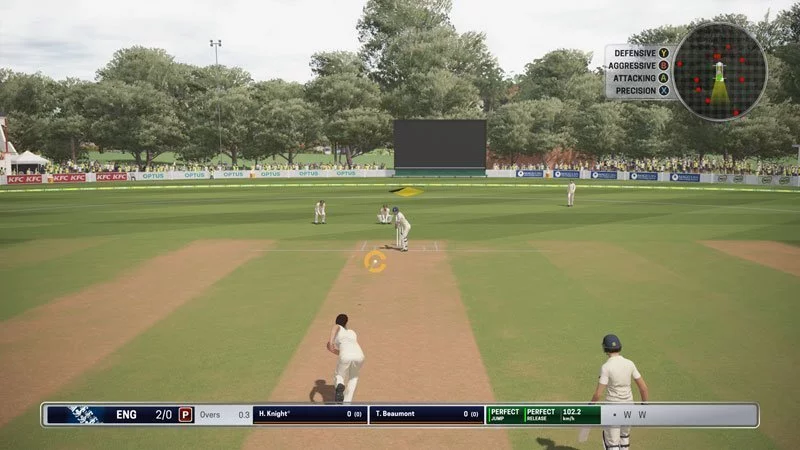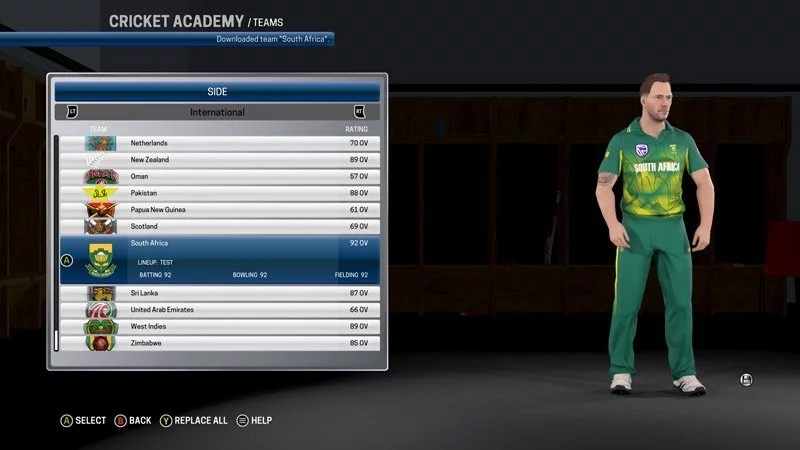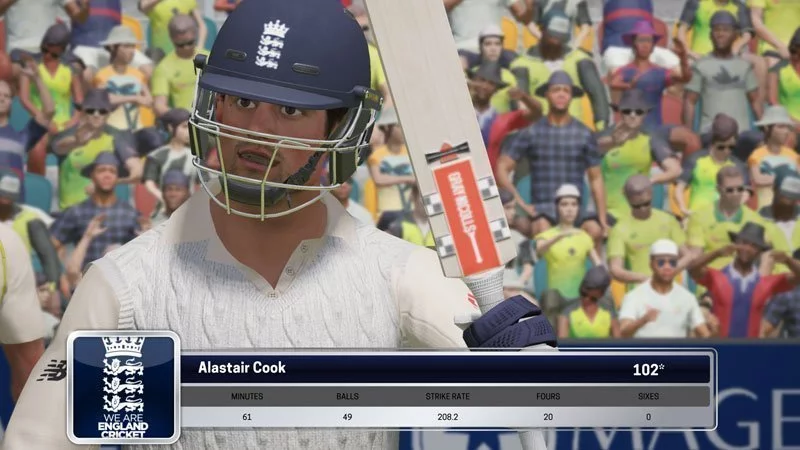Ashes Cricket takes the foundations of the twin Don Bradman Cricket games, adds official licensing of the Australian and English players, the benefits of motion capture, a more comprehensive batting system and, best of all, several tweaks the community has been asking for. Following last year’s Don Bradman Cricket 17, it’s the first annual upgrade for DBC and that’s exactly how it comes across; an improvement on last year’s game rather than a drastic overhaul.
Those changes are largely with bat in hand, as Ashes Cricket introduces a more legitimate 360-degree range for batting (or close to it). Whereas the previous games gave the illusion of such precision, shots tended to fall into predetermined corridors and super human fielders made hitting some gaps impossible. I feel in complete control over shot placement in Ashes Cricket, and confident I can pick the gaps between fielders and take quick singles without a shambolic runout – although cancelling a run is now painfully slow and has been the source of my demise many times. As I tweaked the difficulty, I found the sweet spot where I felt like I could score and hit the gaps, but that I would have to work for runs and be patient in a Test match. I’m sure that balance will be hard to maintain over time, but I haven’t encountered it, at least not this good, in either of the previous games.
It’s made possible by the motion capture of players, enabling batters to move more naturally, and greatly improved physics, which can be modified to suit your taste. Most of the core shots, especially well timed drives, cuts and pull shots, look, sound and feel stunning, free of the mechanical lurch of DBC. The batting, bowling and fielding difficulties can be changed before each match, or you can dive deeper and adjust the bowler or batting modifiers to make specific aspects easier, harder, faster, slower, more realistic or completely ludicrous. If you thought 150km/h bouncers were too slow in DBC17, you’ll find a similar pace by default in Ashes Cricket, but have the power to adjust it precisely to your liking; personally I enjoy the extra split-second to pick line and length.
AI fielders cover more realistic zones, but also dive and make spectacular stops, where once they would have awkwardly waddled around when the ball passed them. The AI team makes more appropriate field changes based on your play, and no longer leaves staggering gaps in limited overs matches. While the AI in general is smarter, it still isn’t able to read the state of the game and doesn’t play to the scoreboard as well as it could.
Greater control when batting comes with an entirely new control scheme. A classic option will appease the muscle memory of returning DBC players, but the new “standard controls” will open it up to mere mortals; the type of cricket fan who don’t cancel family engagements to watch day four of a dead rubber Test match and Big Bash every single night in January (weirdos, right?). If there’s a fault with the dual stick control method, it’s that it takes a long time to learn. Even as a returning player, it takes time to learn the craft of batting and bowling, and much longer to notch a classy century or five wicket haul. Remembering the relatively initiative, yet complicated, controls is no simple feat, but cricket is no simple game.
The simplified control method defaults to the front foot, with the right trigger swapping to backfoot, while the type of shot is determined by the face buttons and aimed using the left stick. It’s almost impossible to change to the opposite stick for veteran DBC batters, but is certainly easier to understand. Regardless, two distinct options gives players choice and should make it more accessible.
Bowling and fielding has taken less of a stride, with few changes outside of the renewed predictability of enhanced ball physics. It’s essentially exactly the same as DBC17, and while there’s a great degree of complexity to bowling, it’s accessible, the most enjoyable and nuanced of any cricket game, and still quickly becomes boring. I can bat for hours, but can’t manually bowl through a session, let alone an entire Test match; thankfully, just like Steve Smith, you never have to bowl if you don’t want to; there are a bunch of options to simulate an entire innings or skip to the next wicket or a particular session of play. Likewise, the ability to simulate while batting at the non-striker’s end keeps things moving.
Ashes mode takes centre stage as Big Ant’s shiny new toy, for the first time featuring the real Steve Smith and Joe Root, instead of imposters. The benefits of having access to the players to capture their likenesses and movements are immense. The core group are considerably more lifelike than the commendable community has been able to generate in previous games, and batsman move much more naturally – the iconic Steve Smith stance in particular is mirrored to perfection. Bowlers still trundle in a little lethargic, but their faces are astonishingly accurate as they wander around the field, which is something I never thought we would experience in a cricket game.
The Ashes contest follows the five Test series from the Gabba to the SCG, with a handful of ODIs and T20Is tagged onto the end. The Women’s Ashes comprises the three ODIs, three T20Is and single day/night Test match used in the multi-format series. The official branding extends to the all major sponsors of the “Magellan Ashes 2017-18”, with Optus adoring the scoreboards, KFC plastered all over the stands and Qantas anchored on the players’ shirts. The grounds are legitimate for the first time, with faithful recreations of the Gabba, Adelaide Oval, WACA, MCG and SCG.
Of course, we’ve always had access to this through the crafty user-generated Cricket Academy, which allows all of the generic teams and players to be replaced with “the best” community made versions, which just happen to mirror reality. As you would expect, the official versions of players are a step above, but there is a dedicated community that makes very accurate teams, and without them the DBC games probably wouldn’t have been successful enough to warrant a licensed Ashes game.
I had worried the partnership with Australian and English cricket might have prohibited the blatant (but ingenious) infringement of likenesses and logos, but it returns to allow you to replace all of the generic international, state and T20 teams with ease. At the time of writing, there aren’t enough community teams to fully test how easy it really is, nor are there any community made stadiums or umpires (and they aren’t licensed); however, updating teams and players now replaces them in an existing career mode file, resolving the biggest problem with the DBC model of releasing the game and asking the community to find its flaws.
Ashes mode has refreshed the presentation, with a HUD that matches the style of Channel Nine and Fox Sports. It’s clean, stylish and remains informative. It cleverly incorporates game specific information, such as the quality of your timing and shot selection, into the rolling display mimicking a broadcast. The only aspect that looks out of place is the optional and long requested fielding radar affixed to the top right-hand corner of screen. You still have an opportunity to look around before each ball is bowled, but being able to track the position of fielders with a quick glance makes for a faster, more enjoyable experience. After all, this is a video game, and not a cricket training simulator where remembering the placement of fielders is critical.
While the Ashes mode takes prime position, it’s the career mode that provides longevity, by virtue of cricket’s fascination with individual accomplishments amongst a team performance. Playing as a single man or woman as part of the XI is enticing in cricket, whereas the entire team can drag games out too much, especially in the longer formats.
Career mode has been refined, and frankly fixed. After spending more than 200 hours in DBC14, I lost interest in DBC17 when its stats disappeared and became woefully inaccurate, defeating the purpose of such an intricate, individualistic mode. Ashes Cricket fixes that horrible blunder with, as far as I can tell, accurate and accessible statistics. I’m loathe to confirm they’re 100% accurate as, while I haven’t found any discrepancies in either my career or overall player stats, the Xbox One Game Hub stats do not correctly record runs. My total runs seem to tick over by one regardless of whether I’ve scored a single or boundary, suggesting it’s tallying scoring shots and not runs. That could be a minor error, and is outside of the actual game, but it does make me worry the significant stat issues of DBC17 haven’t been fully resolved.
While career hasn’t changed much in terms of progression, it does make some welcome tweaks. Once again, choose to start as either an established player, like Steve Smith, already Australian Test Captain, or an 18-year-old rookie. The latter mode sends you to club cricket, which now includes three-day matches instead of just T20 games, where you’ll need to earn your stripes before being called into the state and finally national team at T20, ODI and Test level. Perform well enough, and contracts from lucrative international T20 competitions will be forthcoming, on your way to eventually being named national captain.
Unlike DBC17, players don’t come in and out of the side erratically. It’s more like DBC14 with a fairly stagnant playing XI and occasional promotions, but once you rise the ranks to captain, or simply skip ahead as a star player, you also become the primary selector and can choose the line-up before each game; finally giving you the power to return Ed Cowan to the NSW Shield team. At least this is true for domestic games, as Australian captain, Smith lost all power to select the team, which didn’t change for five (mostly simulated) Test matches. While playing XI selections are still problematic, there are no scheduling issues, as Smith didn’t play any clashing Shield or Big Bash matches while involved in international commitments.
For all that it does right to tidy up gameplay, Ashes Cricket is still plagued by a sense that it’s not quite ready and will, once again, use its full fare paying community to test and report issues. The first wicket I took in the Ashes was a mandatory run out where Alistair Cook disappeared during a run and I couldn’t progress until I ran him out. The camera loves cutting to old school scoreboards between overs, but often the match stats haven’t updated on them, so what’s the point? The tutorials are glitchy, which is a massive problem, and there are still some significant framerate drops even playing on Xbox One X.
The audio is a little better, now comprising a handful of instrumental tracks that are a little too up-tempo for cricket but don’t become infuriating as soon, but the commentary is still atrocious. Michael Slater returns and is joined by one of James Taylor or Mel Jones, who don’t perform much better. The robotic voices aside, the sound bites still don’t match what’s actually happening. When Mel says “swing and a miss”, Michael says, “no shot offered”, so which was it? Then, after being smashed all over the park, James will say it was a great maiden over. It’s now three games with broken commentary, so I’d recommend turning it off and cranking Spotify or commentary from the actual Ashes. If only there was a Nintendo Switch version, you could play and watch at the same time.
Outside of career and the Ashes, there are options to play complete tours or competitions, like a World Cup, or single competitions like the IPL — all unlicensed and in need of community generated teams. As with everything else, these are fully customisable to mitigate the lack of licenses. These, and casual games, can be played locally by up to four players, with two on each team. Short local matches, either Five5 or Ten10 games, are blisteringly fun in local co-op play, while online is also available, though we haven’t been able to test it pre-release, but considering the nature and length of cricket, don’t consider it as important as in other sport games.
Ashes Cricket is the best cricket game ever made, enhancing the foundations of the Don Bradman Cricket series, rather than starting afresh. Player licensing takes it up a notch, as does an improved batting system and motion capture. While there are still too many glitches and commentary remains a mess, it delivers on the pitch with more accessible options for new players and improvements for veterans.
 |
|
The good
|
The bad
|
Ashes Cricket was reviewed using a promotional code on Xbox One X, as provided by the developer. Click here to learn more about Stevivor’s scoring scale.
This article may contain affiliate links, meaning we could earn a small commission if you click-through and make a purchase. Stevivor is an independent outlet and our journalism is in no way influenced by any advertiser or commercial initiative.



